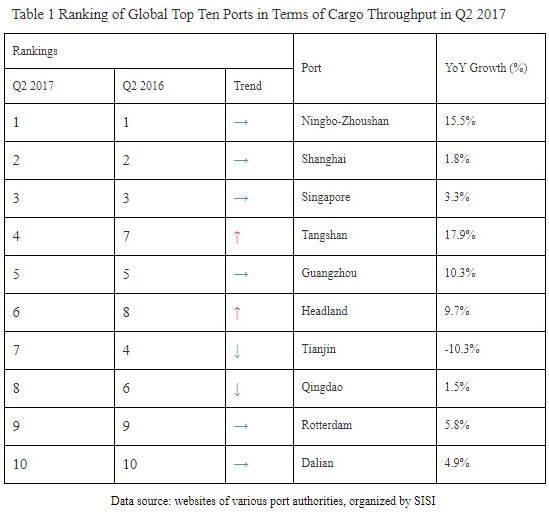Global Port Throughput Maintains Upward Trend
Shanghai International Shipping Institute recently published its Global Port Development Report for the second quarter of 2017, saying that cargo throughputs at major ports around the world continued to rise.
According to the report, the World Bank forecast a global GDP growth rate of 2.7 percent in the second quarter, the growth rate remaining stable on the whole. International trade activities boomed, the foreign trade environment improved and staple commodity prices stood high, thanks to the overall positive world economy.
The cargo throughput at major ports around the world saw a year-on-year increase of 6.8 percent, significantly picking up compared to the growth in the second quarter of 2016. Container throughput at major ports was up by 7.2 percent year on year, and up by 9.8 percent quarter on quarter, with the growth rate rising again compared to that in the previous quarter.
Dry bulk throughputs at major ports around the world presented divergent trends of growth. The dry bulk throughput at Qinhuangdao, China, grew substantially in the second quarter, doubling that in the same quarter of 2016 with an amount of 78.633 million tons. The growth of dry bulk throughput at major ports in Australia slipped as a result of the throughput of the coal terminal at the Port of Hay Point declining by 82 percent in April.
The crude oil market had brisk supply and demand thanks to the continuous decline in global oil prices, and the liquid bulk throughput at major ports around the world sustained the trend of growth of the previous quarter.
In the second quarter, the global terminal operator market enjoyed relatively stable development overall. The major terminal operators around the world covered by the statistics all registered positive growth in terms of the equity throughput, except for COSCO Shipping Ports Limited. Specifically, DP World sustained its good momentum from the previous quarter, ranked the first in terms of growth rate, and its growth rate significantly increased by about five percent compared to that in the same period last year.
The global top ten ports accomplished a cargo throughput of 1.525 billion tons, up by 6.34 percent year on year. Among the global top ten ports, more than half of them had the same ranking as that in the same period last year. As a result of a strong growth in dry bulk throughput, the ranking of Port of Tangshan increased from seventh to fourth position. Impacted by the Trucked Coal Incident in Tianjin, the cargo throughput at Port of Tianjin declined to some extent, accomplishing a cargo throughput of 128.71 million tons, with a growth rate of -10.3 percent.

Under the guidance of China's Belt and Road initiative, waterway transport networks along the Yangtze River and nearby coast continued to grow as both domestic cargo and import and export demand continued to expand.
The major ports in South Korea achieved a cargo throughput of 390 million tons, with a significant increase of 7.0 percent, 6.6 percentage points higher than that in the same period last year. The increase was dominated by the Port of Busan, with a cargo throughput of 100 million tons which was 18.1 percent higher than that in the same period last year and 17.8 percent higher than that in the previous quarter. Kwangyang Port and Taesan Port also achieved significant growth rates of 11.2 percent and 8.9 percent respectively.
Europe sustained the positive growth of the first quarter, with major ports in Europe reaching a cargo throughput of 203 million tons in the second quarter, up by 3.9 percent year on year. The container throughputs at major ports in Europe rose by eight percent year on year, and by 5.3 percent quarter on quarter to 6.757 million TEUs, continuing the growing trend from the previous quarter.
The American economy delivered a good performance on the whole in the second quarter, with the GDP increasing by 2.1 percent year on year, slightly higher than the 2.0 percent in the previous quarter. Container throughput at major ports in America rose on the whole. Specifically, Santos and Vancouver were strong performers, achieving a double-digit growth rate both year on year and quarter on quarter, with their container throughputs registering 948,000 TEUs and 819,000 TEUs respectively in the second quarter.
Boosted by mergers of ports and terminals in the U.S. West Coast, Port of Los Angeles and Port of Long Beach achieved optimized allocation of port resources, and enjoyed a good performance in the second quarter. The container throughput at the Port of Los Angeles increased by 6.6 percent year on year to 2.242 TEUs, while that at the Port of Long Beach increased by 17.6 percent quarter on quarter to 1.865 million TEUs.
Australia's economic growth remained unchanged at 0.5 percent in the second quarter. Coal throughput growth at Australia's ports was sluggish, and the country's dry bulk throughput growth slowed down. Hay Point Coal Terminal, one of the two terminals of Port of Hay Point, Australia's major coal port, saw a sharp decline of 82 percent in coal throughput in April, and only accomplished a coal throughput of 760,000 tons, far lower than the terminal's monthly average coal throughput of 3.5 million tons. Under this impact, the dry bulk throughput growth at major Australian ports was 0.17 percent, dramatically slowing down.
